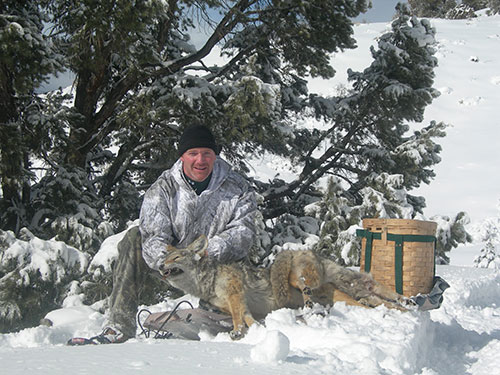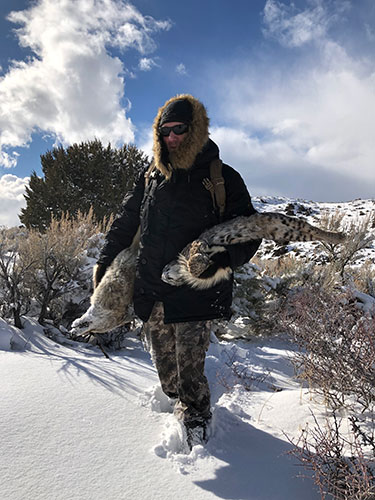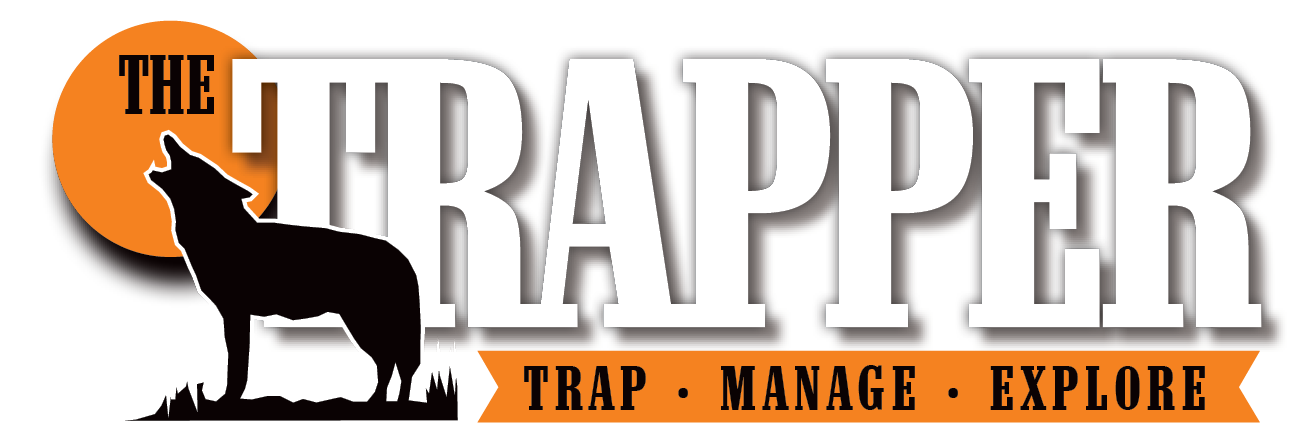Deep snow makes for difficult conditions on the trapline. Here’s how one Western trapper adapts and uses it to his advantage every winter.
Running a snow-filled trapline can be challenging, well at least it was for me this past winter. Definitely a snowy winter wonderland — and then some. I was in some of the deepest snow of the century in my area whether I wanted it or not. I normally embrace any kind of moisture that comes to the driest state in the nation with open arms. This past year the United States received more moisture as a whole than any other time since record keeping began 120 years ago, according to a Washington Post article I read just the other morning.
There’s no doubt that large snowstorms can certainly hamper trapping efforts and spirits. Little things that trappers take for granted every time they run their line, such as easy walking or smooth roads, can change. If I move my ankle just right I can still feel a little ache from a head-over-heels slip off of a snow-filled trail while checking traps at night.
During dry, freezing conditions we can use a concoction of freeze-proof dirt, and in rain we can sift a little more dirt onto traps. However, snow changes things much more dramatically. Snow characteristics include: accumulations, thawing, crusting and properties that make the fluff freeze as hard as concrete.
Snow can also do some pretty magical things on the trapline, aside from being a photogenic environment. The onset of snow can make both prey and predators move around a lot more than they normally would, especially prior to and shortly after a snowstorm. All creatures must eat, and when snow depths increase small prey may have to congregate to areas where there is edible vegetation for consumption. For toothy critters, that means that they must follow the prey or face starvation themselves.
Using the right equipment in snow country can make things much more bearable. I don’t need expensive gear like a snowmobile or a snow cat, but more generalized items that fit the body like good boots, snowshoes, mittens, snowpants and stocking cap are required. There is no use trying to perform the impossible and stay comfortable while cold or wet. Last year I quickly tired of pulling gloves on and off every time that I set traps, baited sets or performed on-the-line skinning efforts. So I bit the bullet and had a pair of fur mittens made for my oversize trapping hands. My little boy, Chase, mentioned that I should have skunk mittens made because I cuss every time that I catch a skunk in a trap.
The first pair of skunk mittens that I had made were great, until I noticed that the more I used them or the more they warmed up, the more that they stunk like skunk. I theorized that the fellow who made them did his own home tanning and couldn’t get the skunks fully de-scented. I first thought of them as more of a novelty, but I soon happily discovered what real warmth felt like on a bitter cold day. Eventually, I had to quit wearing my skunk mittens at winter sporting events because so many people asked about them to the point of annoyance, and occasionally nearby spectators would mention that they smelled a skunk.
Since then I have discovered that if you want a great pair of quality, hand-stitched fur mittens, visit Bob Wiebe at Trigger Taxidermy (Triggerbob@live.com). I was in Canada last winter hunting wolves and made my annual visit to watch Bob stitch his world-renowned wolf mittens. Once you experience wearing good fur mittens, you won’t wear anything else while on the trapline or out hunting. And if you wear fur mittens out on the town, expect attention from fellow citizens.
Other things like good winter tires, a winch, ATV or a snow shovel are also nice to have and can help out some of the deep snow pains. I truly believe that the most important thing to have on the winter trapline is always a good mental attitude. When some of the big storms hit in my area, I see trappers throw in the towel, pull equipment and head home. I have noticed over the years that once a trapper pulls their equipment, most won’t go back at it — even if there are months left in the trapping season. Snow can be a life-sucker for some folks.
There are weeks or even months when snow just doesn’t seem to melt, however, it doesn’t hamper my spirits and I know the snow is nothing more than an inconvenience. So, I must work harder knowing that gains can be made. One of the best gains that I see with good snow is that I catch fewer unwanted species like as skunks and raccoons. There are outstanding advantages when the snow hits, one just has to look for them and stay positive.
When snow blankets the earth it changes the dynamics of all kinds of wildlife. Just as trappers have to adapt to conditions, predators have to burn more calories moving through snow and to stay warm. In boot-depth snow, bobcats are almost up to their bellies, so anything that makes it easier for them to walk in the snow is going to be beneficial for their movement. Trail sets can be key for these kinds of snow conditions. Foxes and badgers seem to follow suit, but I notice that the long-legged coyote does not follow the path of least resistance like many of the short-legged predators. Coyotes appear to march right on through pretty decent snow depths until it gets about knee deep on me, then more coyotes show up in my snow-trail sets.
Temperatures and snow depths dictate how I am going to work my trapline. If the snow stays in the mountains, I might move my sets down the mountain and look for travel corridors. I know that eventually everything on the mountain must come down in elevation when the snow starts to pile up at higher elevations. While it may take some time to move sets, I can find those little transition areas where I may not see any predator sign early in the fall, but then become plentiful as winter wears on. I find that these areas may only be target rich for short periods of time before a couple of things happen. If a warm front moves in and the snow recedes, the predators simply move back up the mountain to resume carving out a living in the places they are most familiar with.
If cold temperatures and snow accumulations persist, then predators will be forced to move down into valleys, and prey can be forced into some pretty tight areas. Even flat prairie country can experience deep snows that force prey and predators into certain areas.
When snows get deep in North Dakota, for example, deer and other prey animals move to small areas of unharvested grain that farmers left behind or spillage around grain bins. When I was a poor wildlife college student I used to remove a lot of coyotes from these winter forage areas. Trapping and calling around wintering grounds were downright magical at times.
Instead of covering vast miles on foot, one only had to travel from grain bin to grain bin. Farmers loved my coyote removal efforts because they could see in the snow where coyotes were killing deer. You wouldn’t believe the places that I was able to hunt because the farmers were so grateful that I was removing a bunch of bothersome coyotes.
In my trapping areas I have learned that if snow comes in big, I can still cash in on predators. This is something that all of us can learn over time. I might only have half of the traps that I normally have out and cover a lot less country, but I have been known to catch the same amount of fur despite the hardships. It may take me longer to run my trapline, but I always seem to find a way to keep going.
When I find my trapping grounds heavily snowed in and it looks like I am going to be snow-rich for a while, I break out the snowshoes and identify where I can sucker punch predators on my own snowshoe trail. I’ll start by taking some walks where I think predators are located. I have a pretty good idea where the rabbit yards are so I usually start there.
Then I’ll skirt a snowshoe trail right through the area for a half-mile to a mile depending on how the country looks. Since I will have to walk back to the truck after a couple of miles, I end up making a nice big horseshoe snow trail. Along the way every so often I take a rake or shovel and clean an area out where there’s a natural pinch point and set a blind set. I will leave a couple of inches of snow on the ground and place the trap right on the snow.
Next, I brush in a light layer of snow as camouflage over the trap. I also try to set the trap where it’s in the shade all day because if the trap is in the sun, a small amount of snow will melt immediately on a trap as the sun heats the metal trap. So, I want to be careful and not put too much snow on the trap to make it nonfunctional, either.
Then I place some large diameter sticks on all sides of the leghold trap to give a box effect. This presents a set that basically constricts the set so that the only place that a predator can step is right on the pan. Since there are nontarget mountain lions also following my snow trails, I box in my sets really tight so that it’s more difficult for mountain lions and to some extent, coyotes, to get caught. Bobcats and gray foxes, however, don’t have a chance.
Blazing the first snowshoe line and setting traps is always the toughest day. That is the day when you invite a friend who wants to go trapping. Friends usually don’t ask to go after the first day, but you can hook them back in for the next trap check by telling them that now they can check traps — with the lure of something being caught. You can make it a long day for them and take them to another desirable area, and run another snowshoe trail laced with even more traps. But, I still haven’t figured out how to get them to come back for a third day on the trapline.
The subsequent trap checks get much easier after you walk time and time again in the exact same snow trail. Sometimes I hook an old tire or a big chunk of dead sheep onto a dog leash then tie it around my waist. Then simply drag the tire or bait along the trapline. They can both groom the trail nicely, and the bait chunk makes it a canine-catching highway. If the snow stays for several weeks I can really clean up on critters in an area — to the point of having to find new areas.
Predators are suckers for well-groomed snow trails, but so are other less desirable species such as rabbits and deer. Every time that a deer, cow, mountain lion, horse or rabbit trips my traps, it is basically stealing a predator’s chance to get caught. Coyotes and foxes follow behind my meat trail every week somewhere on the line. The only way to describe the scent-filled trail is like when a mouse attempts to eat cheese from a mouse trap, it doesn’t know why the cheese is free, but it has to try and eat it anyway. The results can be quiet favorable.
To save time I really try to minimize nontarget catches. Sometimes there are areas that just have a lot of undesirable opportunities, so to combat the dilemma, I set more traps out to make sure that I am covered for any eventful occasion. A rake comes in handy for releasing nontarget animals in normal years. But last year there was so much snow that I had to forgo the rake and bring out the snow shovel to clear spots to place my sets.
This past winter brought some new challenges on the trapline. There was a two-week period when the snow was 1½ feet deep and the temperatures were freezing, and the snow made no attempt to leave. I had punched out several miles of trails and dozens of traps were set and ready for an unsuspecting predator. On one particularly memorable morning, I headed out before daylight. I was dressed for the day’s abnormally low temperatures and armed with my occasionally stinky skunk mittens
As soon as I began walking up the trail I saw where a pair of coyotes had turned onto the trail, following my sheep drag from a few days prior. Somehow both coyotes managed to walk over the first set, however, the next set was a leg hold and there was a female coyote in it. After dispatching the coyote, I walked to the next set where a trail snare looked to be missing. I looked over the bank and there was the big, frozen male coyote. I was only three sets into a long line and 50 pounds of predators already hit the ground.
All throughout the day I picked up coyotes and gray foxes, and finally at the end of the line there was a bobcat tied up. Tracks in the snow showed where a coyote had walked a tight circle around the trapped bobcat. Apparently it decided that the bobcat was a bit too much to take on, so the unsuspecting coyote walked down the trail and right into my next blind set, which cinched the coyotes fate.
That was a trap day that I had to send a grip-and-grin self photo with a pile of coyotes to my wife. Then, I sheepishly had to ask her for a ride back to my truck.
Snow is not always a welcome sight and often causes sore eyes for me on the trapline, but I have learned that Mother Nature will do what she wants to do and there is nothing that I can do about it. Instead of giving up on the line, I simply lace up the boots, slip on the mittens, strap on the snowshoes and make trapping opportunities happen.





